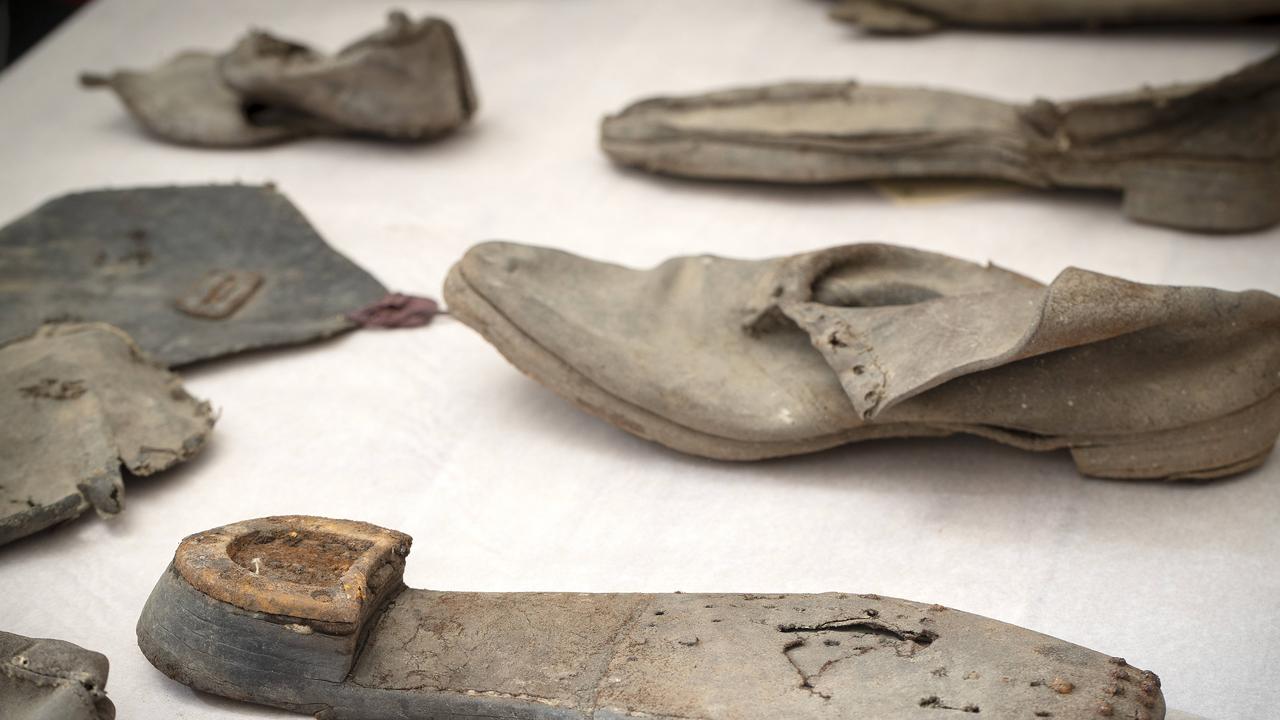Archaeological dig unearths boots and all in Tasmania
Old leather boots and pieces of tattered clothing, likely worn by British soldiers and convicts more than 180 years ago, have been uncovered during an archaeological dig in Tasmania

READING LEVEL: GREEN
Old leather boots and pieces of tattered* clothing, likely worn by British soldiers and convicts more than 180 years ago, are among artefacts* uncovered during an archaeological dig in Tasmania.
Experts say the discovery of about 1800 artefacts, including leather shoes and boots, clothing remains, and numerous ceramic, metal, bone and wooden items, is of national significance*.
The discovery was made below Hobart’s Anglesea Barracks officers’ mess hall*, previously a soldiers’ barracks, built in 1827-1828.
“It has been one of those really amazing finds,” said director of Latitude Heritage Dr Jennifer Jones-Travers.
“In assessing* the site for its research values and rarities* specifically, it is of national significance.”

About 70 individual boots were found. Most were made with timber pegs as well as welt* construction, dating back to the early 19th century.
“The find was quite unusual, in the number of textiles and boots, and they represented really early colonial garments for both of the military convicts and as well as possibly free settlers,” Dr Jones-Travers said.
“We really don’t understand in a great sense how people were dressed in those days.
“Having the ability to see so many bits of textile, how they are really making use of the resources they have is really just so exciting.”

One of the key finds is a collar from a jacket stamped with a soldier’s name – T Lannon – from the 63rd Regiment* and dating back to 1829 to 1834 when that regiment was in Hobart.
But Dr Jones-Travers said it was not known if the soldier was ever in Hobart.
“Interestingly, the name of that soldier isn’t picked up by the Tasmanian names index* or the rolls of soldiers that were present,” Dr Jones-Travers said.
“So, you almost wonder if it might be part of that recycling and getting from Britain any sort of clothing you can.”
Defence, environment and sustainability manager Dr Kate Hibbert said the discovery was a surprise.
“I was going about my business one day and a builder working underneath the mess came in with an old dirty boot and put it on my desk and I said ‘What have we got here’,” she recalled.

“The size of the find is really unusual. The way organic materials break down in environments means we don’t find this sort of stuff very often.”
Dr Hibbert said it was likely another building that belonged to a cobbler* or tailor was originally at the site and was knocked over and built on top of for a second soldiers’ barracks. It is now a mess hall for officers.
The next step is conserving the artefacts, including cataloguing* every item for future research and storing them at the Anglesea Barracks museum.
GLOSSARY
- tattered: a torn and hanging part or piece of cloth
- artefacts: any object made by human beings, especially one of an earlier era
- mess hall: a room in which a group of people, such as soldiers, regularly eat their meals
- assessing: to rate the value of something
- rarities: the state of being rare and having value
- welt: a strip of leather sewn along the seam that joins the sole and upper of a shoe to reinforce the seam
- regiment: a troop of soldiers made up of two or more battalions
- names index: an alphabetical list of names in a book
- cobbler: a person who makes or fixes shoes or boots
- cataloguing: to create an organised list of things
EXTRA READING
Abstract painting hung upside down for decades
Stolen sarcophagus lid returned to Egypt
Row over ‘discovery’ of Captain Cook’s shipwreck
QUICK QUIZ
- What different kind of artefacts were discovered?
- What were the old boots made of and when do they date back to?
- How many boots were found overall?
- Why did Dr Kate Hibbert think the discovery was such a surprise?
- What is the old soldiers barracks used for now?
LISTEN TO THIS STORY
CLASSROOM ACTIVITIES
1. National significance
Why do you think these items are of national significance?
What information could finding these artefacts give to Australia’s history?
Why do you think the materials of these items didn’t break down like others have done in the past?
Time: allow 15 minutes to complete this activity
Curriculum Links: English, History, Personal and social, Critical and creative thinking
2. Extension
T Lannon was the name of a soldier stamped onto a collar found from these items dating back 180 years ago.
Who might T Lannon have been?
Why isn’t he on the soldier register?
Why have his clothes ended up underground?
Time: allow 10 minutes to complete this activity
Curriculum Links: English, History, Critical and creative thinking
VCOP ACTIVITY
History uncovered
The amazing thing about archaeology, is what we can learn about history.
Using some of the facts and theories from the article, see if you can recreate your own theory as to why all these artefacts were in this location.
Obviously is a guessing game as we weren’t there, but you never know, maybe you are right!
Re-read your work to make sure it makes sense. Check your VCOP skills to see if you have hooked the reader in and given enough detail in your work.

